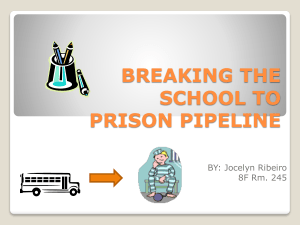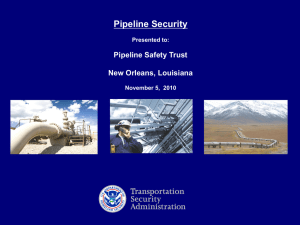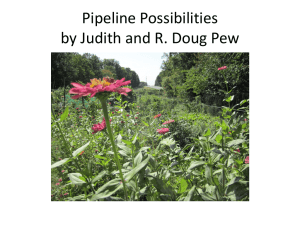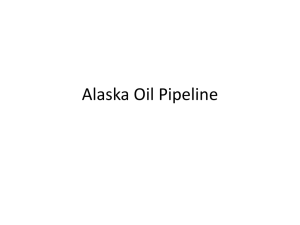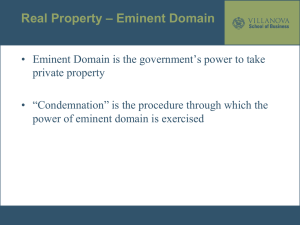Natural Gas Liquids Pipelines in Kentucky
advertisement
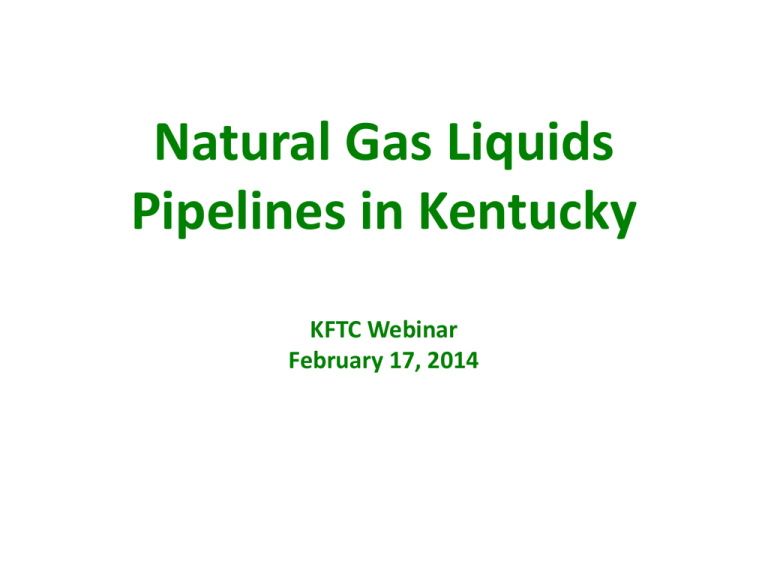
Natural Gas Liquids Pipelines in Kentucky KFTC Webinar February 17, 2014 What are Natural Gas Liquids? • When natural gas is extracted from the ground, the chief component is "methane," or what we typically think of as natural gas used to heat homes. • Other components include gases like ethane, propane, pentane, hexane, heptane and butane that are in liquid form under high pressure and turn to a gas in normal atmospheric conditions. • Once the methane is removed, the remaining product needs to be “fracinated” or processed to separate out the individual gases that are used by petrochemical plants for making plastics, feedstock or fuel. Proposed Bluegrass Hazardous Liquids Pipeline 6 • New NGL pipeline from fracking areas in WV, PA and OH to connect with Boardwalk’s Texas Gas Pipeline in Hardinsburg, KY • a portion of Texas Gas Pipeline from Hardinsburg, KY to LA re-purposed from natural gas to NGLs • 24- or 26-inch pipeline would be buried 2-4 feet underground • at full capacity, would carry 400,000 barrels of NGLs per day Bluegrass Pipeline New Construction Kinder Morgan / MarkWest NGL Pipeline Existing Ranger NGL Pipeline Purchased/built by MarkWest in 2011/2012. Capacity 19,000 barrels per day. Concerns About NGL Pipelines Overall Safety Leaks Karst areas Suitability of re-purposed pipeline Treatment of landowners Lack of siting oversight Safety Concern #1 There are 26,751 miles of pipelines in Kentucky, but only 908 miles (3.4%) carry hazardous liquids. Just 4.1% of these are NGLs. However, these hazardous liquids pipelines represent: • • • • 30.9% of all incidents between 2003 and 2012; 66.6% of all injuries; 67.3% of all property damage and 100% of the gross barrels spilled in these incidents. Moreover, despite clean up efforts, 29.1% of the barrels spilled from hazardous liquid pipelines in Kentucky were not recovered or removed from the environment. Research courtesy of Dr. Lorraine Garkovich (University of Kentucky) Safety Concern #2 According to the U.S. Pipeline and Hazardous Materials Safety Administration data, there is a “significant incident” involving a hazardous liquids pipeline every 3 days. A significant incident is defined as one involving: – – – – a death an injury requiring hospitalization $50,000 or more in property damage, or the release of 5 barrels or more of highly volatile liquid Safety Concern #3 • The best pipeline monitoring equipment can detect a leak only when there is a 1.8% or greater drop in pressure. • At 400,000 barrels per day, this means more than 300,000 gallons could leak every day without being detected. • A Wall Street Journal analysis found that fewer than 20% of leaks are detected by pipeline control centers set up for that purpose. Safety Concern #4 • NGLs are transported in a pressurized liquid state but become an odorless and colorless vapor once they hit the air when leaks occur. • NGL vapor is heavier than air and will stay low to the ground, settling in valleys, creeks, rivers or other low points. • These vapors are highly flammable and can be ignited by heat, spark or flame. • In the event of a suspected leak, turn off all tractors or car engines, do not turn on anything electric and walk to higher ground. Safety Concern #5 • When leaked, about 80% of NGLs turn to gas. • The other 20% remains a liquid and may contaminate the soil and water. • “You’ve got to be nuts to put a large diameter HVL [high volatile liquids pipeline] in a karst terrain.” (pipeline expert Richard Kuprewicz) Proximity to homes Suitability of re-purposed pipeline • All the proposed re-purposed pipe for Bluegrass and Tennessee Gas pipelines were manufactured prior to 1970. • Pre-1970 NG pipe was longitudinally welded with obsolete welding technology that is well known to fail along the weld seam. • Pre-1970 NG pipe used obsolete exterior protective coatings that are known to disbond, and therefore reduce protection against corrosion. Research provided by Dick Watkins. Exxon Mobil Repurposed Pipeline Weld Seam Rupture and Liquid Spill, Mayflower, AR 2013 (pipe manufactured with LF-ERW) Treatment of landowners Eminent Domain • The company stated numerous times publicly and many times privately to individual landowners that it believes it has the power to use eminent domain. • Landowners feel threatened that their land will be condemned for a pipeline easement. • “I was told that if I did not allow the company to survey my property, I would be taken to court, and they would win.” Woodford County landowner) Eminent Domain Legislation Senate Bill 14 • SB 14 simply restricts eminent domain authority to any “utility under the jurisdiction of the Public Service Commission.” • This bill is based on a simple principle that there should be a direct public use and benefit before eminent domain can be used, and that there is an accountable public agency that oversees that use. Of the three bills, this does the most to limit eminent domain. • SB 14 is assigned to the Senate Judiciary Committee. Eminent Domain Legislation Senate Bill 21, House Bill 60 • SB 21 and HB 60 would restrict eminent domain authority to “pipelines for transporting or delivering oil or gas that is subject to the severance tax imposed under KRS 143A.020, and refined oil and gas products …” • Under this bill, private oil and gas companies and individuals that are not regulated as public utilities and do not provide a public use would be able to use eminent domain power if they paid severance tax on the product in their pipeline, and are “in public service.” While this is currently the case for some private pipelines, SB 21 / HB 60 may have the effect of broadening eminent domain for these private companies. • HB 60 is assigned to the House Judiciary Committee. SB 21 is assigned to the Senate Judiciary Committee. Eminent Domain Legislation House Bill 31 • HB 31 would allow the Public Service Commission to grant condemnation authority to “common carriers” for oil and gas and their related products if “in the public interest” and considerate of protecting the environment, safety, reasonableness of the facility’s siting, and whether it promotes “a safe and efficient transportation infrastructure.”. PSC could do so according to a process that allows for public input and a public hearing, if requested. • This bill is more about establishing a process for allowing private companies like Bluegrass Pipeline LLC to gain eminent domain powers than it does to prevent such companies from getting it. • HB 31 is assigned to the House Judiciary Committee. What’s Next? • House Judiciary Committee to hear testimony on HB 31 on Wednesday, February 19 at 12 noon in Capitol Annex Room 171. • The bill is expected to be amended to address concerns about the weakness of current language. • Public testimony will be allowed. House Bill 387 • HB 387 addresses the lack of oversight by any state agency as to the siting of a Natural Gas Liquids pipeline. • HB 387 would require anyone constructing an NGL pipeline to apply for a construction certificate from the Kentucky State Board on Electric Generation and Transmission. • The board will determine if the proposed pipeline route takes minimizes the potential adverse effects of the routing on other uses of land, and on land, air, and water resources, and may deny a construction permit if it has not. Ways to Stay Informed • • • • KFTC blog and website: www.kftc.org http://nobluegrasspipeline.com www.stopbluegrasspipeline.us Facebook: Bluegrass Pipeline Blockade Sign the petition to the U.S. Army Corps of Engineers asking that it require a full Environmental Impact Statement for the entire length of the Bluegrass Pipeline. www.kftc.org/BGPpetition-corps

